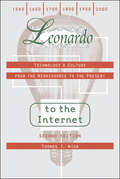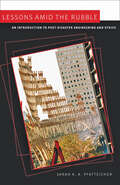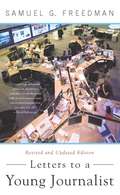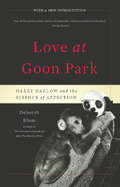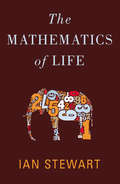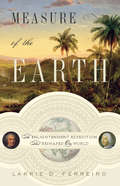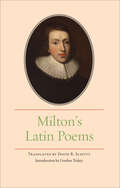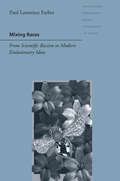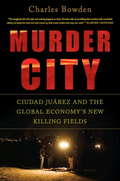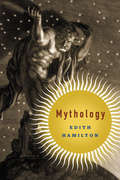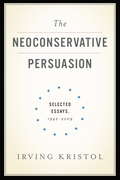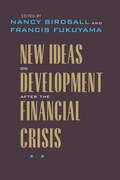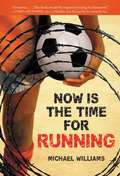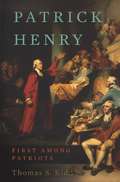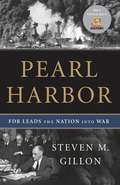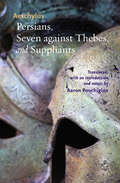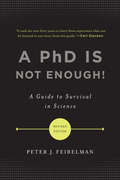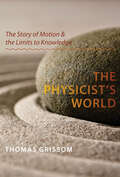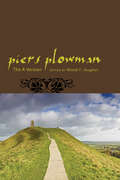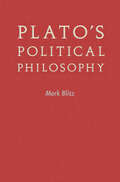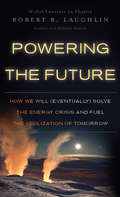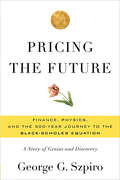- Table View
- List View
Leonardo to the Internet: Technology and Culture from the Renaissance to the Present (Johns Hopkins Studies in the History of Technology)
by Thomas J. MisaHistorian Thomas J. Misa’s sweeping history of the relationship between technology and society over the past 500 years reveals how technological innovations have shaped—and have been shaped by—the cultures in which they arose. Spanning the preindustrial past, the age of scientific, political, and industrial revolutions, as well as the more recent eras of imperialism, modernism, and global security, this compelling work evaluates what Misa calls "the question of technology."Misa brings his acclaimed text up to date by examining how today's unsustainable energy systems, insecure information networks, and vulnerable global shipping have helped foster geopolitical risks and instability. A masterful analysis of how technology and culture have influenced each other over five centuries, Leonardo to the Internet frames a history that illuminates modern-day problems and prospects faced by our technology-dependent world
Lessons amid the Rubble: An Introduction to Post-Disaster Engineering and Ethics (Johns Hopkins Introductory Studies in the History of Technology)
by Sarah K. PfatteicherThe aftermath of September 11, 2001, brought the subject of engineering-failure forensics to public attention as had no previous catastrophe. In keeping with the engineering profession's long tradition of building a positive future out of disasters, Lessons amid the Rubble uses the collapse of the World Trade Center towers to explore the nature and future of engineering education in the United States. Sarah K. A. Pfatteicher draws on historical and current practice in engineering design, construction, and curricula to discuss how engineers should conceive, organize, and execute a search for the reasons behind the failure of man-made structures. Her survey traces the analytical journey engineers take after a disaster and discusses the technical, social, and moral implications of their work. After providing an overview of the investigations into the collapse of the Twin Towers, Pfatteicher explores six related events to reveal deceptively simple lessons about the engineering enterprise, each of which embodies an ethical dilemma at the heart of the profession. In tying these themes together, Pfatteicher highlights issues of professionalism and professional identity infused in engineering education and encourages an explicit, direct conversation about their meaning.Sophisticated and engagingly written, this volume combines history, engineering, ethics, and philosophy to provoke a deep discussion about the symbolic meaning of buildings and other structures and the nature of engineering.
Letters to a Young Journalist (Art Of Mentoring Ser.)
by Samuel G. FreedmanOver the course of a thirty-year career, Samuel Freedman has excelled both at doing journalism and teaching it, and he passionately engages both of these endeavors in the pages of this book. As an author and journalist, Freedman has produced award-winning books, investigative series, opinion columns, and feature stories and has become a specialist in a wide variety of fields. As a teacher, he has shared his expertise and experience with hundreds of students, who have gone on to succeed in both print and broadcast media. In Letters to a Young Journalist, Freedman conducts an extended conversation with young journalists-from kids on the high school paper to graduates starting their first jobs. Whether he's talking about radio documentaries or TV news shows, Internet blogs, or backwater beats, shoeleather research or elegant prose, his goal is to explore the habits of mind that make an excellent journalist. It is no secret that journalism's mission is seriously imperiled these days, and Freedman's provocative ideas and fascinating stories offer students and journalists at all levels of experience wise guidance and professional inspiration.
Love at Goon Park: Harry Harlow and the Science of Affection
by Deborah BlumIn the early twentieth century, affection between parents and their children was discouraged-psychologists thought it would create needy kids, and doctors thought it would spread infectious disease. It took a revolution in psychology to overturn these beliefs and prove that touch ensures emotional and intellectual health. In Love at Goon Park, Pulitzer Prize winner Deborah Blum charts this profound cultural shift by tracing the story of Harry Harlow-the man who studied neglect and its life-altering consequences on primates in his lab. The biography of both a man and an idea, Love at Goon Park ultimately invites us to examine ourselves and the way we love.
The Mathematics of Life: Unlocking The Secrets Of Existence
by Ian Stewart"Will this book do for biomathematics what Stephen Hawking's A Brief History of Time did for relativity and cosmology? Time will tell. Until then, the distinguished author's friendly, well-argued style should guarantee its popular success." --Times Higher Education Supplement (London)Biologists have long dismissed mathematics as being unable to meaningfully contribute to our understanding of living beings. Within the past ten years, however, mathematicians have proven that they hold the key to unlocking the mysteries of our world--and ourselves. In The Mathematics of Life, Ian Stewart provides a fascinating overview of the vital but little-recognized role mathematics has played in pulling back the curtain on the hidden complexities of the natural world--and how its contribution will be even more vital in the years ahead. In his characteristically clear and entertaining fashion, Stewart explains how mathematicians and biologists have come to work together on some of the most difficult scientific problems that the human race has ever tackled, including the nature and origin of life itself.
Measure of the Earth: The Enlightenment Expedition That Reshaped Our World
by Larrie D. FerreiroIn the early eighteenth century, at the peak of the Enlightenment, an unlikely team of European scientists and naval officers set out on the world&’s first international, cooperative scientific expedition. Intent on making precise astronomical measurements at the Equator, they were poised to resolve one of mankind&’s oldest mysteries: the true shape of the Earth. In Measure of the Earth, award-winning science writer Larrie D. Ferreiro tells the full story of the Geodesic Mission to the Equator for the very first time. It was an age when Europe was torn between two competing conceptions of the world: the followers of René Descartes argued that the Earth was elongated at the poles, even as Isaac Newton contended that it was flattened. A nation that could accurately determine the planet&’s shape could securely navigate its oceans, giving it great military and imperial advantages. Recognizing this, France and Spain organized a joint expedition to colonial Peru, Spain&’s wealthiest kingdom. Armed with the most advanced surveying and astronomical equipment, they would measure a degree of latitude at the Equator, which when compared with other measurements would reveal the shape of the world. But what seemed to be a straightforward scientific exercise was almost immediately marred by a series of unforeseen catastrophes, as the voyagers found their mission threatened by treacherous terrain, a deeply suspicious populace, and their own hubris.A thrilling tale of adventure, political history, and scientific discovery, Measure of the Earth recounts the greatest scientific expedition of the Enlightenment through the eyes of the men who completed it—pioneers who overcame tremendous adversity to traverse the towering Andes Mountains in order to discern the Earth&’s shape. In the process they also opened the eyes of Europe to the richness of South America and paved the way for scientific cooperation on a global scale.
Milton's Latin Poems
by Gordon TeskeyIn this collection, esteemed poet and translator David R. Slavitt brings to life John Milton’s Latin poetry with deft, imaginative modern English translations.While Milton is recognized as one of the most learned English poets in history, his Latin poetry is less well known. Slavitt’s careful rendering brings Milton’s Latin poems—many written in his late teens—into the present. He keeps true to the style of the originals, showing Milton’s maturing poetic voice and the freedom he found working in Latin. On the Gunpowder PlotO, sly Guy Fawkes, you plotted against your king and the British lords, but did you intend to be kindand make up for your malice in this thing with at least a show of piety? Do we findan intention, perhaps, of sending the members of court up to the sky in a chariot made of firethe way Elijah traveled. Or do I distort the simple wickedness of your desire?Featuring an introduction by Gordon Teskey, this comprehensive English-language collection of Milton’s Latin poems pays due respect to a master. Poetry lovers, Milton fans, and scholars of either will welcome, enjoy, and learn from this work.
Mixing Races: From Scientific Racism to Modern Evolutionary Ideas (Johns Hopkins Introductory Studies in the History of Science)
by Paul Lawrence FarberThis book explores changing American views of race mixing in the twentieth century, showing how new scientific ideas transformed accepted notions of race and how those ideas played out on college campuses in the 1960s.In the 1930s it was not unusual for medical experts to caution against miscegenation, or race mixing, espousing the common opinion that it would produce biologically dysfunctional offspring. By the 1960s the scientific community roundly refuted this theory. Paul Lawrence Farber traces this revolutionary shift in scientific thought, explaining how developments in modern population biology, genetics, and anthropology proved that opposition to race mixing was a social prejudice with no justification in scientific knowledge.In the 1960s, this new knowledge helped to change attitudes toward race and discrimination, especially among college students. Their embrace of social integration caused tension on campuses across the country. Students rebelled against administrative interference in their private lives, and university regulations against interracial dating became a flashpoint in the campus revolts that revolutionized American educational institutions. Farber’s provocative study is a personal one, featuring interviews with mixed-race couples and stories from the author’s student years at the University of Pittsburgh. As such, Mixing Races offers a unique perspective on how contentious debates taking place on college campuses reflected radical shifts in race relations in the larger society.
Murder City: Ciudad Juarez and the Global Economy's New Killing Fields
by Charles Bowdenp.p1 {margin: 0.0px 0.0px 0.0px 0.0px; font: 11.0px Calibri} span.s1 {font-kerning: none} Ciudad Juarez lies just across the Rio Grande from El Paso, Texas. A once-thriving border town, it now resembles a failed state. Infamously known as the place where women disappear, its murder rate exceeds that of Baghdad.In Murder City, Charles Bowden-one of the few journalists who spent extended periods of time in Juarez-has written an extraordinary account of what happens when a city disintegrates. Interweaving stories of its inhabitants-a beauty queen who was raped, a repentant hitman, a journalist fleeing for his life-with a broader meditation on the town's descent into anarchy, Bowden reveals how Juarez's culture of violence will not only worsen, but inevitably spread north.Heartbreaking, disturbing, and unforgettable, Murder City was written at the height of his powers and established Bowden as one of America's leading journalists.
Mythology: Timeless Tales Of Gods And Heroes (Mentor Ser.)
by Edith Hamilton Aphrodite Trust Apollo TrustThe world-renowned classic that has enthralled and delighted millions of readers with its timeless tales of gods and heroes.Edith Hamilton's mythology succeeds like no other book in bringing to life for the modern reader the Greek, Roman and Norse myths that are the keystone of Western culture-the stories of gods and heroes that have inspired human creativity from antiquity to the present.We follow the drama of the Trojan War and the wanderings of Odysseus. We hear the tales of Jason and the Golden Fleece, Cupid and Psyche, and mighty King Midas. We discover the origins of the names of the constellations. And we recognize reference points for countless works for art, literature and culture inquiry-from Freud's Oedipus complex to Wagner's Ring Cycle of operas to Eugene O'Neill's Mourning Becomes ElectraBoth a reference text for scholars of all ages and a book to simply enjoy, Mythology is a classic not to be missed.
The Neoconservative Persuasion: Selected Essays, 1942-2009
by Irving KristolIrving Kristol, the "godfather" of neoconservatism and one of our most important public intellectuals, played an extraordinarily influential role in the development of American intellectual and political culture over the past half century. These essays, many hard to find and reprinted here for the first time since their initial appearance, are a penetrating survey of the intellectual development of one of the progenitors of neoconservatism.Kristol wrote over the years on a remarkably broad range of topics--from W. H. Auden to Ronald Reagan, from the neoconservative movement's roots in the 1940s at City College to American foreign policy, from religion to capitalism. Kristol's writings provide us with a unique guide to the development of neoconservatism as one of the leading strains of thought--one of the leading "persuasions"--in recent American political and intellectual history.
New Ideas on Development after the Financial Crisis (Forum on Constructive Capitalism)
by Francis Fukuyama Nancy BirdsallThe global financial crisis of 2008–9 has changed the way people around the world think about development. The market-friendly, lightly regulated model of capitalism promoted by the United States is now at risk, and development thinking worldwide is at something of an impasse. Editors Nancy Birdsall and Francis Fukuyama bring together leading scholars to explore the implications of the global financial crisis on existing and future development strategies.In addressing this issue, the contributors contemplate three central questions: What effect has the crisis had on current ideas in development thinking? How has it affected and how will it affect economic policy and political realities in Latin America and Asia, including China and India? Will the financial collapse reinforce shifts in geopolitical power and influence, and in what form? Essays answering these questions identify themes that are essential as economic and political leaders address future challenges of development.To help move beyond this time of global economic turmoil, the contributors—the foremost minds in the field of international development—offer innovative ideas about stabilizing the international economy and promoting global development strategies. Contributors: Nancy Birdsall, Center for Global Development; Michael Clemens, Center for Global Development; Kemal Derviş, Brookings Institution; Larry Diamond, Stanford University; Francis Fukuyama, Stanford University; Peter S. Heller, Johns Hopkins University; Yasheng Huang, Massachusetts Institute of Technology; Justin Yifu Lin, World Bank; José Antonio Ocampo, Columbia University; Mitchell A. Orenstein, Johns Hopkins University; Minxin Pei, Claremont McKenna College; Lant Pritchett, Harvard University; Liliana Rojas-Suarez, Center for Global Development; Arvid Subramanian, Johns Hopkins University
Now Is the Time for Running
by Michael WilliamsJust down the road from their families, Deo and his friends play soccer in the dusty fields of Zimbabwe, cheered on by Deo's older brother, Innocent. It is a day like any other... until the soldiers arrive and Deo and Innocent are forced to run for their lives, fleeing the wreckage of their village for the distant promise of safe haven in South Africa. Along the way, they face the prejudice and poverty that greet refugees everywhere, but eventually Deo finds hope, joining dozens of other homeless, displaced teens on the World Cup Street Soccer team--a possible ticket out of extreme hardship to a new life.Captivating and timely, Now Is the Time for Running is a staggering story of survival that follows Deo and his brother on a transformative journey that will stay with readers long after the last page.
Patrick Henry: First Among Patriots
by Thomas S. KiddMost Americans know Patrick Henry as a fiery speaker whose pronouncement "Give me liberty or give me death!” rallied American defiance to the British Crown. But Henry's skills as an orator-sharpened in the small towns and courtrooms of colonial Virginia-are only one part of his vast, but largely forgotten, legacy. As historian Thomas S. Kidd shows, Henry cherished a vision of America as a virtuous republic with a clearly circumscribed central government. These ideals brought him into bitter conflict with other Founders and were crystallized in his vociferous opposition to the U.S. Constitution. In Patrick Henry, Kidd pulls back the curtain on one of our most radical, passionate Founders, showing that until we understand Henry himself, we will neglect many of the Revolution's animating values.
Patrick Henry: First Among Patriots
by Thomas S KiddMost Americans know Patrick Henry as a fiery speaker whose pronouncement "Give me liberty or give me death!" rallied American defiance to the British Crown. But Henry's skills as an orator -- sharpened in the small towns and courtrooms of colonial Virginia -- are only one part of his vast, but largely forgotten, legacy. As historian Thomas S. Kidd shows, Henry cherished a vision of America as a virtuous republic with a clearly circumscribed central government. These ideals brought him into bitter conflict with other Founders and were crystallized in his vociferous opposition to the U.S. Constitution. In Patrick Henry, Kidd pulls back the curtain on one of our most radical, passionate Founders, showing that until we understand Henry himself, we will neglect many of the Revolution's animating values.
Pearl Harbor: FDR Leads the Nation Into War (Playaway Adult Nonfiction Ser.)
by Steven M. GillonFranklin D. Roosevelt famously called December 7, 1941, "a date which will live in infamy.” History would prove him correct; the events of that day-when the Japanese bombed Pearl Harbor-ended the Great Depression, changed the course of FDR's presidency, and swept America into World War II. In Pearl Harbor, acclaimed historian Steven M. Gillon provides a vivid, minute-by-minute account of Roosevelt's skillful leadership in the wake of the most devastating military assault in American history. FDR proved both decisive and deceptive, inspiring the nation while keeping the real facts of the attack a secret from congressional leaders and the public.Pearl Harbor explores the anxious and emotional events surrounding the attack on Pearl Harbor, showing how the president and the American public responded in the pivotal twenty-four hours that followed, a period in which America burst from precarious peace into total war.
Persians, Seven against Thebes, and Suppliants (Johns Hopkins New Translations from Antiquity)
by AeschylusAaron Poochigian’s new translations of Aeschylus’s earliest extant plays provide the clearest rendering yet of their formal structure. The distinction between spoken and sung rhythms is as sharp as it is in the source texts, and for the first time readers in English can fully grasp the balanced, harmonious arrangement of choral odes. The importance of these works to the history of drama and tragedy and to the history of classical literature is beyond question, and their themes of military hubris and foreign versus native are deeply relevant today. Persians offers a surprisingly sympathetic portrayal of the Athenians’ most hated enemy; in Seven against Thebes Argive invaders, though no less Greek than the Thebans themselves, are portrayed as barbarians; and in Suppliants the city of Argos is called upon to protect Egyptian refugees. Based on textual evidence and the archaeological remains of the Theater of Dionysus at Athens, Poochigian’s introductory overview of stage properties and accompanying stage directions allow readers to experience the plays as they were performed in their own time. He is most careful in his translations of the plays’ choral odes. Instead of rendering them with little or no form, Poochigian has preserved the comprehensive structures Aeschylus himself employed. Readers are thus able to recognize Aeschylus as a master of poetry as well as of drama. Poochigian’s translations are the most accurate renditions of the poetry and dramaturgy of the original works available. Intended to be both read as literature and performed as plays, these translations are lucid and readable, while remaining staunchly faithful to the texts.
A PhD Is Not Enough!: A Guide to Survival in Science
by Peter J. FeibelmanEverything you ever need to know about making it as a scientist.Despite your graduate education, brainpower, and technical prowess, your career in scientific research is far from assured. Permanent positions are scarce, science survival is rarely part of formal graduate training, and a good mentor is hard to find.In A Ph.D. Is Not Enough!, physicist Peter J. Feibelman lays out a rational path to a fulfilling long-term research career. He offers sound advice on selecting a thesis or postdoctoral adviser; choosing among research jobs in academia, government laboratories, and industry; preparing for an employment interview; and defining a research program. The guidance offered in A Ph.D. Is Not Enough! will help you make your oral presentations more effective, your journal articles more compelling, and your grant proposals more successful.A classic guide for recent and soon-to-be graduates, A Ph.D. Is Not Enough! remains required reading for anyone on the threshold of a career in science. This new edition includes two new chapters and is revised and updated throughout to reflect how the revolution in electronic communication has transformed the field.
The Physicist's World: The Story of Motion and the Limits to Knowledge
by Thomas GrissomHow do students learn about physics without picking up a 1,000-page textbook chock-full of complicated equations? The Physicist’s World is the answer. Here, Thomas Grissom explains clearly and succinctly what physics really is: the science of understanding how everything in the universe moves.From the earliest efforts by Presocratic philosophers contemplating motion to the principal developments of physics through the end of the twentieth century, Grissom tells the unfolding story of our attempt to quantify the material world and to conceptualize the nature of physical laws. Through the centuries, questions about why things move proved to be unanswerable in any absolute, satisfying way. Instead the question became how things move, a direction of thought that led to the rise of modern science. Physics emerged as a mathematical description of the motion of matter and energy, a description believed to be complete and exact, limited only by the precision of measurement. Grissom shows that in one of the great intellectual ironies, advancements in twentieth-century physics affirmed instead that this quantitative theory was capable of discovering its own limits. There is only so much that physics can reveal about the world. This is physics for the thinking person, especially students who enjoy learning concepts, histories, and interpretations without becoming mired in complex mathematical detail. A concise survey of the field of physics, Grissom’s book offers students and professionals alike a unique perspective on what physicists do, how physics is done, and how physicists view the world.
The Physicist's World: The Story of Motion and the Limits to Knowledge
by Thomas GrissomHow do students learn about physics without picking up a 1,000-page textbook chock-full of complicated equations? The Physicist’s World is the answer. Here, Thomas Grissom explains clearly and succinctly what physics really is: the science of understanding how everything in the universe moves.From the earliest efforts by Presocratic philosophers contemplating motion to the principal developments of physics through the end of the twentieth century, Grissom tells the unfolding story of our attempt to quantify the material world and to conceptualize the nature of physical laws. Through the centuries, questions about why things move proved to be unanswerable in any absolute, satisfying way. Instead the question became how things move, a direction of thought that led to the rise of modern science. Physics emerged as a mathematical description of the motion of matter and energy, a description believed to be complete and exact, limited only by the precision of measurement. Grissom shows that in one of the great intellectual ironies, advancements in twentieth-century physics affirmed instead that this quantitative theory was capable of discovering its own limits. There is only so much that physics can reveal about the world. This is physics for the thinking person, especially students who enjoy learning concepts, histories, and interpretations without becoming mired in complex mathematical detail. A concise survey of the field of physics, Grissom’s book offers students and professionals alike a unique perspective on what physicists do, how physics is done, and how physicists view the world.
Piers Plowman: The A Version
by Mí 267 Eál F. VaughanThe fourteenth-century Piers Plowman is one of the most influential poems from the Age of Chaucer. Following the character Will on his quest for the true Christian life, the three dream narratives that make up this work address a number of pressing political, social, moral, and educational issues of the late Middle Ages. Míceál F. Vaughan presents a fresh edition of the A version, an earlier and shorter version of this great work.Unlike the B and C versions, there is no modern, affordable edition of the A version available. For the first time in decades, students and scholars of medieval literature now have access to this important work. Vaughan’s clean, uncluttered text is accompanied by ample glossing of difficult Middle English words. An expansive introduction, which includes a narrative summary of the poem, textual notes, detailed endnotes, and a select bibliography frame the text, making this edition ideal for classroom use.This is the first classroom edition of the A version since Thomas A. Knott and David C. Fowler’s celebrated 1952 publication. Based on an early-fifteenth-century manuscript from the University of Oxford’s Bodleian Library, Vaughan’s text offers a unique rendition of the poem, and it is the first modern edition not to attribute the poem to William Langland. By conservatively editing one important witness of Piers Plowman, Vaughan takes a new generation of students to an early version of this great medieval poem.
Piers Plowman: The A Version
by Míċeál F. VaughanThe fourteenth-century Piers Plowman is one of the most influential poems from the Age of Chaucer. Following the character Will on his quest for the true Christian life, the three dream narratives that make up this work address a number of pressing political, social, moral, and educational issues of the late Middle Ages. Míċeál F. Vaughan presents a fresh edition of the A version, an earlier and shorter version of this great work.Unlike the B and C versions, there is no modern, affordable edition of the A version available. For the first time in decades, students and scholars of medieval literature now have access to this important work. Vaughan’s clean, uncluttered text is accompanied by ample glossing of difficult Middle English words. An expansive introduction, which includes a narrative summary of the poem, textual notes, detailed endnotes, and a select bibliography frame the text, making this edition ideal for classroom use.This is the first classroom edition of the A version since Thomas A. Knott and David C. Fowler’s celebrated 1952 publication. Based on an early-fifteenth-century manuscript from the University of Oxford’s Bodleian Library, Vaughan’s text offers a unique rendition of the poem, and it is the first modern edition not to attribute the poem to William Langland. By conservatively editing one important witness of Piers Plowman, Vaughan takes a new generation of students to an early version of this great medieval poem.
Plato's Political Philosophy
by Mark BlitzThis comprehensive, yet compact, introduction examines Plato's understanding of law, justice, virtue, and the connection between politics and philosophy.Focusing on three of Plato's dialogues—The Laws, The Republic, and The Statesman—Mark Blitz lays out the philosopher's principal interests in government and the strength and limit of the law, the connection between law and piety, the importance of founding, and the status and limits of political knowledge. He examines all of Plato's discussions of politics and virtues, comments on specific dialogues, and discusses the philosopher's explorations of beauty, pleasure, good, and the relations between politics and reason. Throughout, Blitz reinforces Plato's emphasis on clear and rigorous reasoning in ethics and political life and explains in straightforward language the valuable lessons one can draw from examining Plato's writings.The only introduction to Plato that both gathers his separate discussions of politically relevant topics and pays close attention to the context and structure of his dialogues, this volume directly contrasts the modern view of politics with that of the ancient master. It is an excellent companion to Plato's Dialogues.
Powering the Future: How We Will (Eventually) Solve the Energy Crisis and Fuel the Civilization of Tomorrow (Playaway Adult Nonfiction Ser.)
by Robert B. LaughlinIn Powering the Future, Nobel laureate Robert B. Laughlin transports us two centuries into the future, when we&’ve ceased to use carbon from the ground—either because humans have banned carbon burning or because fuel has simply run out. Boldly, Laughlin predicts no earth-shattering transformations will have taken place. Six generations from now, there will still be soccer moms, shopping malls, and business trips. Firesides will still be snug and warm.How will we do it? Not by discovering a magic bullet to slay our energy problems, but through a slew of fascinating technologies, drawing on wind, water, and fire. Powering the Future is an objective yet optimistic tour through alternative fuel sources, set in a world where we&’ve burned every last drop of petroleum and every last shovelful of coal. The Predictable: Fossil fuels will run out. The present flow of crude oil out of the ground equals in one day the average flow of the Mississippi River past New Orleans in thirteen minutes. If you add the energy equivalents of gas and coal, it&’s thirty-six minutes. At the present rate of consumption, we&’ll be out of fossil fuels in two centuries&’ time. We always choose the cheapest gas. From the nineteenth-century consolidation of the oil business to the California energy crisis of 2000-2001, the energy business has shown, time and again, how low prices dominate market share. Market forces—not green technology—will be the driver of energy innovation in the next 200 years. The laws of physics remain fixed. Energy will still be conserved, degrade entropically with use, and have to be disposed of as waste heat into outer space. How much energy a fuel can pack away in a given space is fixed by quantum mechanics—and if we want to keep flying jet planes, we will need carbon-based fuels. The Potential: Animal waste.If dried and burned, the world&’s agricultural manure would supply about one-third as much energy as all the coal we presently consume. Trash. The United States disposes of 88 million tons of carbon in its trash per year. While the incineration of waste trash is not enough to contribute meaningfully to the global demand for energy, it will constrain fuel prices by providing a cheap supply of carbon. Solar energy.The power used to light all the cities around the world is only one-millionth of the total power of sunlight pouring down on earth&’s daytime side. And the amount of hydropump storage required to store the world&’s daily electrical surge is equal to only eight times the volume of Lake Mead. PRAISE FOR ROBERT B. LAUGHLIN &“Perhaps the most brilliant theoretical physicist since Richard Feynman&”—George Chapline, Lawrence Livermore National Laboratory &“Powerful but controversial.&”— Financial Times &“[Laughlin&’s] company … is inspirational.&” —New Scientist
Pricing the Future: Finance, Physics, and the 300-year Journey to the Black-Scholes Equation
by George G. SzpiroOptions have been traded for hundreds of years, but investment decisions were based on gut feelings until the Nobel Prize-winning discovery of the Black-Scholes options pricing model in 1973 ushered in the era of the "quants.” Wall Street would never be the same. In Pricing the Future, financial economist George G. Szpiro tells the fascinating stories of the pioneers of mathematical finance who conducted the search for the elusive options pricing formula. From the broker's assistant who published the first mathematical explanation of financial markets to Albert Einstein and other scientists who looked for a way to explain the movement of atoms and molecules, Pricing the Future retraces the historical and intellectual developments that ultimately led to the widespread use of mathematical models to drive investment strategies on Wall Street.
